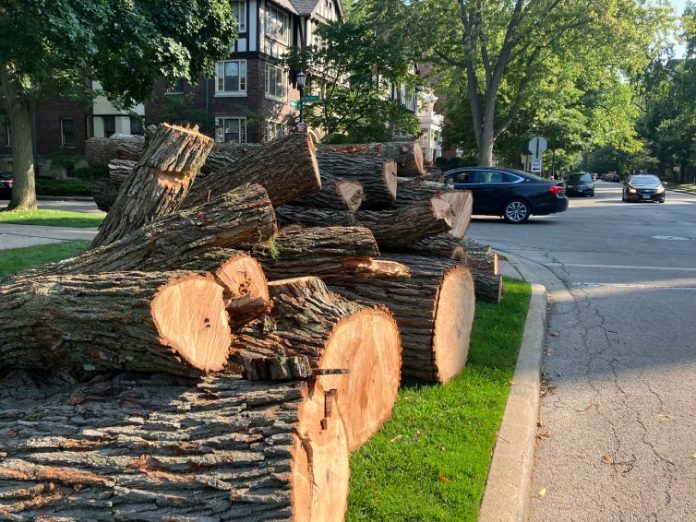City Council passed an ordinance Monday that will extend the city’s tree protections to private property. Credit: Bob Seidenberg
Evanston’s status as a Tree City USA community took on special meaning Monday, as City Council approved the city’s first ordinance protecting trees on private property.
Council members approved the ordinance as part of their consent agenda.
According to one study, at least 70% and likely closer to 80% of the tree canopy in Evanston is on private property.
Until now, trees on private property were not regulated by city code, except for those growing on parcels larger than two acres, “and property owners can freely remove and otherwise impact their trees,” wrote Emily Okallau, the city’s public services coordinator, in a memo.
Under the new ordinance, property owners who want to remove trees on their property with a trunk diameter of six or more inches must do the following to receive a city permit:
- If the property owners are proposing construction within 25 feet of a tree, a tree review application will have to be filled out providing information about the work they intend to do. “That proposal would then be integrated into the workflow of other types of building permits as appropriate,” Okallau said in a presentation at the council’s Aug. 28 meeting.
- In non-construction instances, property owners will have to request a preservation permit for removal approval, officials said. A tree that is dead, critically diseased, hazardous or regarded as an invasive species may be advanced for removal. Otherwise the property owner would have to request a variation from the city’s Human Services Committee, with the city’s arborist providing facts on the case.
The new ordinance also requires protection of trees during excavation or construction, and replacement of any removed trees or payment of a mitigation fee. The rules for replacement vary depending on the species of tree being removed, with stiffer requirements for more beneficial varieties.
For example, Group A trees are generally regarded to have “significantly valuable ecosystem and community contributions; often (but not exclusively) native; high quality habitat for other plants and animals; appropriate for public spaces; are neither invasive nor aggressive propagators.” The tree preservation policy adopted as part of the ordinance lists 43 species as Group A trees, including red and sugar maples, American and hybrid elms and several varieties of oak trees.
Staff looks to Wilmette
The issue of a tree preservation ordinance has been around since a referral from then-First Ward Council Member Judy Fiske in 2019, Okallau wrote in her memo.
In June 2020, council members accepted a staff report on the subject but placed it on file, “as there was no ability to implement due to staffing cuts associated with the COVID-19 pandemic response,” Okallau wrote.
Then last year, the council’s Planning & Development Committee took up the topic again and directed the city’s Environment Board to develop an ordinance protecting trees on private property.
The Environment Board, in turn, sought assistance from city staff, which looked into neighboring communities that had private tree ordinances, Okallau said.
“Municipal staff from those communities shared that their private tree ordinances are largely ineffective in protecting trees because they do not deter removal; instead, they impose large mitigation fees for property owners who remove trees, which disproportionately impacts financially vulnerable property owners,” Okallau wrote. “It is the opinion of these municipal staff that this model of private tree ordinance is ‘better than nothing’ because ‘at least some trees are being planted on private property.’
“The only community with a different type of tree preservation ordinance is Wilmette, and City staff spoke at length with Wilmette’s staff,” she wrote. “Wilmette only allows for tree removal when the request is associated with a building permit. To remove a tree without an associated building permit, property owners must seek a variation from the Village Board; there have been no such variation requests in the two years since the ordinance was passed.”
Staffers in the Community Development Department had raised some concerns about the new proposal when it went before the Planning & Development Committee, particularly how it might slow the department’s work to meet the demand on permits.
Okallau estimated in her memo that approximately 700 permits may require a tree preservation permit review per year. She acknowledged that implementation of the ordinance will result in increased permit cost and may increase issuance times by up to 14 days.
“However, staff anticipates tree preservation reviews will be done concurrently with other reviews (zoning, engineering, stormwater, building, and fire),” she wrote, “so it is likely that most tree preservation reviews will be complete within the current 10-day turnaround City staff seeks to achieve. Delays are most likely to occur when tree preservation application materials are incomplete, or tree preservation reviews result in changes to the proposed project plans, triggering an additional review by all departments.”
In accord with climate goals
Environment Board members as well as staff have spoken about the importance of protecting trees to the city’s Climate Action and Resilience Plan (CARP).
Addressing the Council at its July meeting, Cherie LeBlanc Fisher, who was co-chair of the Environment Board for four years, said, “When we have intense rainstorms, trees keep soil from eroding and absorb stormwater. When we have smoke from Canadian wildfires … our trees help clean the air. It is easy to think of trees on private property as privately owned, but they are a community resource that benefits everyone.”
She added that “removing just one mature tree eliminates benefits that cannot be replaced for decades by planting small trees.”
evanstonroundtable.com
https://evanstonroundtable.com/2023/09/12/evanston-tree-preservation-ordinance-private-property-trees/













